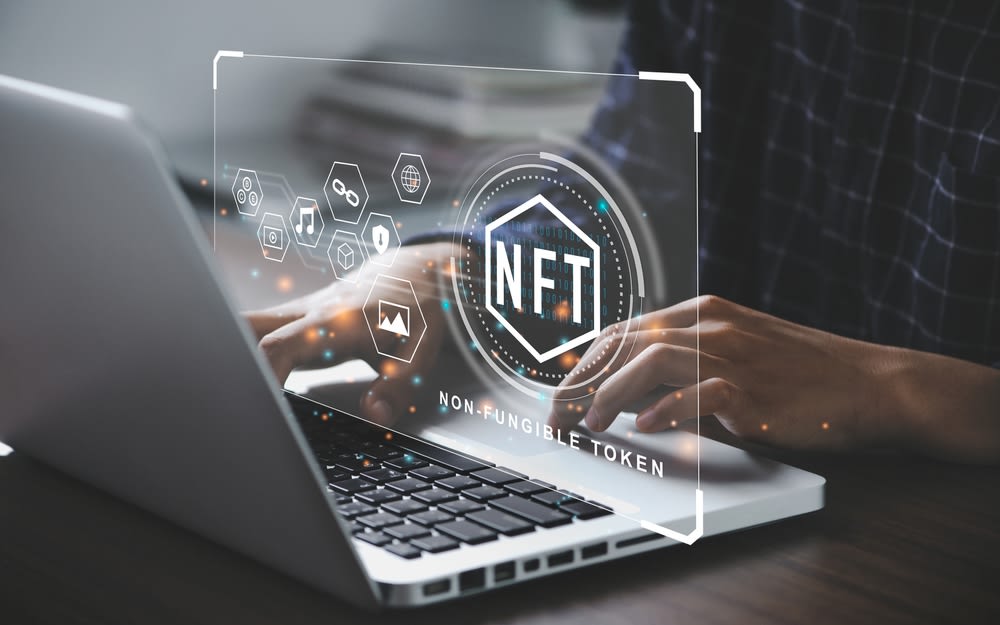What do I need to know before buying an NFT art
Before you purchase an NFT, be sure to check the seller's profile, previous sales, and market volume to ensure you're making a solid investment.
 May 23, 2022
May 23, 2022 7 minute reading
7 minute reading
Although each investment is unique, the foundations of investing are often the same. You must comprehend what you are purchasing, whether it is a work of art, corporate shares, cryptocurrencies, or your first NFT. NFT art took the world by storm last year, as the average trading volume per month of NFTs increased from $64 million in the first half of 2021 to over $700 million in the second half.
People spend huge amounts of money on digital collectibles, ranging from artwork to sports trading cards. If you want to invest a substantial amount of money in an NFT, it is crucial to examine the following aspects. So, what precisely should you verify prior to making a purchase?
Things to Consider Before Buying Your First NFT
The genesis of the NFTs
First of all, it is paramount to understand how NFTs are created. NFTs are created by a minting procedure. Subsequently, minting NFTs generates a representation of a file on the blockchain network. These distributed networks keep immutable records of the asset's purchase and sale as well as its present owner. Ethereum is the network of choice for an overarching majority of these digital artworks, but Cardano and Solana are also employed.
The creation of the NFT facilitates its later purchase, sale, or exchange. It is vital to remember that even if someone copies the NFT's underlying file, the owner will not change unless the existing owner permits it. It is impossible to copy an NFT and sell or trade it under the premise that it is identical to the original NFT.
Whitelist Opportunities
If you are looking to buy your first NFT, you may have heard about the whitelist. In conclusion, whitelists may be a terrific method to earn more money from your NFTs, and it is essential to be aware of the several advantages of being whitelisted.
What is a whitelist then? An NFT whitelist is the procedure that expressly grants a wallet address access to a certain privilege for a particular NFT project. Whitelisting offers early access and discounted mint pricing for a limited period. Additionally, whitelists prevent increasing transaction costs (gas wars).
Vision for the Future Developments
You need to have a strong grasp as soon as possible of what the seller sees as the future possibilities and aspirations for this specific NFT collection. Do they want to sell it to collectors who will then resell it to other people? Or do they want to sell it to purchasers who will keep it?
How exactly will the value proposition (utility) be given throughout the course of time? If there are any long-term objectives, what are they, and do you think they are reasonable? Take into consideration the fact that the future vision is probably not going to pan out if it appears like it is too wonderful to be true.
Utility of the NFT - Value Proposition
Unless the project is art-based and its value is limited to the NFT art sector, determine what the NFT serves. For instance, NFT designers might focus solely on the visual aspects of the NFTs.
Is the value restricted to the digital realm, or does it also exist in the physical world? Utility encompasses the underlying value of a project. Let’s take the example of a unique snapshot of a celebrity as an NFT, which has both digital and physical value, but a meme template NFT possesses just digital value.
Examine what the NFT can accomplish for you, unless the endeavor is purely artistic in nature, in which case its usefulness will be limited to the art world alone. Is the value confined to the realm of the internet, or does it carry over into the physical world as well? The worth of a project is referred to as its utility. A meme template NFT, on the other hand, only has value in the digital realm, in contrast to an exclusive image of a celebrity used as an NFT, which has value in both the digital and real-world contexts.
Distribution of Rarity
One of the primary things that should be examined is represented by the rarity of the NFT. The distribution might be super rare, rare, or ordinary. The most likely distribution percentages are as follows:
Super Rare - Extremely uncommon NFTs are often the most precious. Therefore, their dispersion is less than 3 %.
Rare - The distribution of rare occurrences might exceed 5 %. 5-10 % is a realistic estimate for rare items.
Ordinary - Normal NFTs are quite prevalent. Therefore, their dispersion exceeds 85 %. The most likely distribution is 88 to 94 %.
Marketplace Reputation and Characteristics
You may purchase NFTs on a variety of sites, including Opensea, Solea, Super Rare, Binance NFT, etc. Before doing so, you must answer the following questions to determine the optimal NFT marketplace for you: What is the level of liquidity on the platform? If there is not much, it will be difficult to find a buyer in the future. You will also be restricted in your purchasing options.
Various NFT platforms are now developing on the market, and not all of them are reputable. Before investing in any NFTs, it is essential to do research and only interact with platforms that have a solid reputation. This will protect you from fraud and guarantee that you get the NFTs you purchased.
Transparency is one of the characteristics you must search for in a platform in this instance. For example, you may check to see whether their social media accounts are constantly updated and monitor their pricing on a daily basis to ensure that no one is selling NFTs for more than their stated value. Furthermore, check the reviews of other customers who have previously used these sites, as this will give you a sense of their reliability.

Transaction Costs
Transaction fees are often assessed when exchanging bitcoin, purchasing an NFT, or performing a similar operation on a market platform. The same is true for conventional e-commerce platforms such as eBay and Depop, however, platform-specific fees apply.
Some commissions are set, while others are based on a percentage of the sale; before committing, you should ensure you are aware of both types. For example, OpenSea charges a 2.5 % transaction fee for sellers, of which OpenSea receives 2.5 % of the selling value. Nonetheless, there is no transaction cost for purchasers. This holds true for most NFT markets, including Known Origin and Axie.
Conversely, some platforms impose fees on both sides of the transaction, such as Rarible, which adds a 2.5 % fee to the NFT price for every transaction for the buyer. Make sure you are informed of any costs associated with your platform of choice prior to making any purchases.
Understand the Risks of Buying NFTs
There are currently several hazards involved with crypto-collectibles since NFTs are subject to major market risks, including financial and regulatory risks. Experts believe that any digital underpinning may be readily copied and lead to counterfeiting, which is one of the most significant concerns linked with non-fiat currencies.
Because crypto-collectibles are not governed by a single institution, you are responsible for your own security (unlike with fiat currency, where banks hold your money for you). If you lose the private key (akin to a login) linked with an NFT, no one else will be able to spend or transfer it. This implies that if you lose your private key, you risk losing all of the value contained in the NFT.
Seller’s Verification
Before purchasing a non-fungible token on any online marketplace, you should see the seller's verification after selecting your first non-fungible token. Legitimate vendors on platforms such as OpenSea will also have a blue verification checkmark next to their online username, similar to Twitter or Instagram, to demonstrate that they can be identified and are thus not fake profiles. If you want to buy from a well-known vendor, such as World of Women or Cool Cats NFT, ensure that the NFT artist’s profile has been confirmed.
However, the verification mark cannot always be used to confirm the vendor's legitimacy. Similar to some social media superstars, many legitimate NFT dealers still do not have their verification tick on specific websites. If you wish to purchase from such an unverified profile, you should validate the NFT characteristics. Examine the seller's social media pages for a significant number of followers and a verification checkmark, since this may suggest their validity. You may also examine their sales figures to see whether it is a long-established account or a new account delivering your desired but first NFT.
NFT Liquidity and Market Volume
It is essential to keep in mind that NFTs may not have the same liquidity as cryptocurrencies. Because NFTs cannot be converted into fiat currency as easily as cryptocurrencies, this might provide a challenge for anybody seeking to profit from them. To increase the liquidity of your NFTs, several specialists advocate fractionalizing them, or splitting them into small bits.
In addition to liquidity, the market volume of the NFT business should be examined. Increases or decreases in NFT market volume mainly depend on the types of NFTs obtained often. The NFT industry, as you may be aware, is still in its infancy. Therefore, it is always important to examine the liquidity and market volume of your preferred initial NFT.
Price Performance of the Seller's Other NFTs
Checking the seller's profile is essential if you want to ensure that the NFT you have chosen is a solid investment. You may view their previous sales to determine the prices of their things. Then, you may go down the ranks to see how much identical NFTs sold weeks or months ago. The floor price constitutes the minimum price at which NFTs may be exchanged. This will give you a good grasp of how the values of NFTs move and if they coincide with what you expect to see in your chosen NFT in the near future.
Some platforms give comparable information as well as additional facts that may not be available in the marketplace. Remember to check out NFT Stats and CoinMarketCap if you are interested in learning more about NFT sales, value, growth, and more. Before purchasing your first NFT, it is essential to evaluate the pricing performance of the seller's previous NFTs.
Be Aware of the Risks
Due to the novelty of NFTs as an investment form, most financial professionals advise against investing more than you can afford to lose. Probably not a smart option if losing the purchase price of an NFT will cause you to worry or put you in a poor financial situation.
Be careful that the field of NFTs is rife with conjecture, hype, and outright fraud. There is no assurance that the values of non-fungible tokens will continue to climb; in fact, many may decline. Therefore, you should only gamble with money you can afford to lose. If prices decline, it will not be financially catastrophic. Take your time and take pleasure in learning about the new world of digital ownership.
Concluding Matters
Prior to purchasing NFTs, it is essential to understand what they are and why their value is growing. And to truly comprehend the risks associated with this form of investing, you must educate yourself about blockchain technology.


